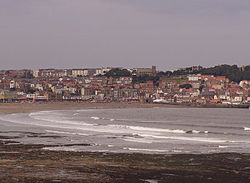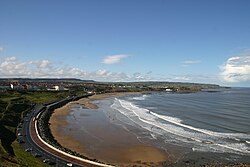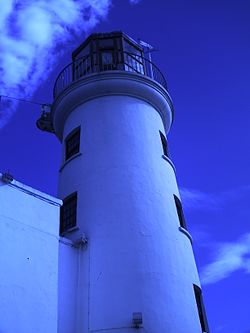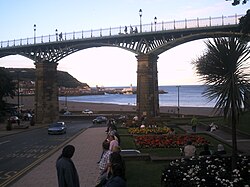Scarborough, North Yorkshire: Difference between revisions
imported>John Stephenson (York) |
imported>John Stephenson (Castle; fishing; university) |
||
| Line 48: | Line 48: | ||
</div> | </div> | ||
'''Scarborough''' is a [[town]] located on the [[North Sea]] coast of [[North Yorkshire]], [[England]], 42 [[mile]]s from the [[city]] of [[York]]. The modern town lies 30 to 70 metres above sea level, on limestone cliffs. The older part of the town lies around the harbour and is protected by a rocky headland | '''Scarborough''' is a [[town]] located on the [[North Sea]] coast of [[North Yorkshire]], [[England]], 42 [[mile]]s from the [[city]] of [[York]]. The modern town lies 30 to 70 metres above sea level, on limestone cliffs. The older part of the town lies around the harbour and is protected by a rocky headland, topped by the twelfth-century ruins of [[Scarborough Castle]]. | ||
Scarborough has a population of around | Scarborough has a population of around 52,000, and is the largest [[seaside resort|holiday resort]] on the Yorkshire coast. It is primarily known as the [[United Kingdom|UK]]'s northernmost resort, and as a former [[spa]] town where the wealthy once visited to take the recuperative waters. Scarborough is also a port for the North Sea [[fishing]] industry, and has become a [[university]] town, home to one campus of the [[University of Hull]]. | ||
The town has a North Bay and a South Bay. The South Bay is the main focus and contains several arcades and entertainment facilities, and is overlooked by the town itself - popular locally for its shopping and nightlife. The North Bay has traditionally been the more peaceful end of the resort and is home to Peasholm Park which has recently been granted funding to be restored to its Japanese-themed glory. The park still features a mock maritime battle (based on the [[Battle of the River Plate]]) re-enacted on the boating lake with large model boats and fireworks throughout the summer holiday season. The [[Scarborough North Bay Railway|North Bay Railway]] is a [[miniature railway]] which runs from the park to the Sea Life Centre at Scalby Mills. | The town has a North Bay and a South Bay. The South Bay is the main focus and contains several arcades and entertainment facilities, and is overlooked by the town itself - popular locally for its shopping and nightlife. The North Bay has traditionally been the more peaceful end of the resort and is home to Peasholm Park which has recently been granted funding to be restored to its Japanese-themed glory. The park still features a mock maritime battle (based on the [[Battle of the River Plate]]) re-enacted on the boating lake with large model boats and fireworks throughout the summer holiday season. The [[Scarborough North Bay Railway|North Bay Railway]] is a [[miniature railway]] which runs from the park to the Sea Life Centre at Scalby Mills. | ||
Revision as of 23:36, 12 March 2007
| Scarborough |
| Latitude: 54.277331 |
| Longitude: -0.401791 |
| OS Grid Reference: TA040880 |
| Population: 50,135[1] |
| District: Borough of Scarborough |
| Region: Yorkshire and the Humber |
| County: North Yorkshire |
| Traditional: (North Riding of) Yorkshire |
| Country: England |
| State: United Kingdom |
| Parliamentary Constituency: Scarborough and Whitby |
| European Region: Yorkshire and the Humber |
| Post Codes: YO11, YO12, YO13 |
| Dialling Code: 01723 |
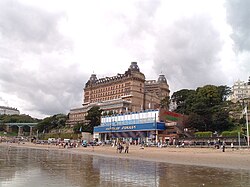
Scarborough is a town located on the North Sea coast of North Yorkshire, England, 42 miles from the city of York. The modern town lies 30 to 70 metres above sea level, on limestone cliffs. The older part of the town lies around the harbour and is protected by a rocky headland, topped by the twelfth-century ruins of Scarborough Castle.
Scarborough has a population of around 52,000, and is the largest holiday resort on the Yorkshire coast. It is primarily known as the UK's northernmost resort, and as a former spa town where the wealthy once visited to take the recuperative waters. Scarborough is also a port for the North Sea fishing industry, and has become a university town, home to one campus of the University of Hull.
The town has a North Bay and a South Bay. The South Bay is the main focus and contains several arcades and entertainment facilities, and is overlooked by the town itself - popular locally for its shopping and nightlife. The North Bay has traditionally been the more peaceful end of the resort and is home to Peasholm Park which has recently been granted funding to be restored to its Japanese-themed glory. The park still features a mock maritime battle (based on the Battle of the River Plate) re-enacted on the boating lake with large model boats and fireworks throughout the summer holiday season. The North Bay Railway is a miniature railway which runs from the park to the Sea Life Centre at Scalby Mills.
The North Bay is linked to the South Bay by an extensive Victorian promenade, built around the headland and soon to be home to the controversial large-scale sculpture The Wave, consisting of "21 steel members, each element a deconstructed section of a wave, which when viewed as an overall composition recreates the wave cycle". Overlooking both bays is Scarborough Castle, which was bombarded by the German warships Derfflinger and von der Tann in the First World War. Both bays have popular sandy beaches and numerous rock-pools at low tide.
Slightly less well known is the South Cliff Promenade situated above the Spa and South Cliff Gardens, commanding excellent views of the South Bay and old town. Its splendid Victorian styling is still intact and the mix of quality hotels and desirable apartments form the backdrop to the ITV drama The Royal which can often be seen filming in the area. The South Bay has the largest illuminated "Star Disk" anywhere in the UK. It is 26 metres across and is fitted with subterranean lights representing the 42 brightest stars and major constellations that can be seen from Scarborough in the northern skies.
History
The town was founded around 966 AD as Skarðaborg by Thorgils Skarthi, a Viking raider, though in the 4th century there had briefly been a Roman signal station on Scarborough Headland, and there is evidence of much earlier Stone Age and Bronze Age settlements. However, the new settlement was soon burned to the ground by a rival band of Vikings under Tosti, Lord of Falsgrave, and Harald III of Norway. The destruction and massacre meant that very little remained to be recorded in the Domesday survey of 1085. Scarborough recovered under King Henry II who built a stone castle on the headland, and granted charters in 1155 and 1163, permitting a market on the sands, and establishing rule by Burgesses.
Edward II gave Scarborough Castle to his favourite, Piers Gaveston. In his castle at Scarborough, Gaveston was besieged by the barons, captured and carried to Oxford for execution.
In the Middle Ages, Scarborough Fair permitted in a royal charter of 1253, held a six-week trading festival attracting merchants from all over Europe. It ran from Assumption Day, the 15th of August, until Michaelmas Day, the 29th September. The fair continued to be held for 500 years, from the 11th to the 18th century, and is commemorated in the song "Scarborough Fair":
- "Are you going to Scarborough Fair?
- —parsley, sage, rosemary and thyme...".
Scarborough and its castle changed hands seven times between Royalists and Parliamentarians during the English Civil War, of the 1640s, enduring two lengthy and violent sieges. Following the civil war much of the town lay in ruins.
In 1626, Mrs Elizabeth Farrow discovered a stream of acidic water running from one of the cliffs to the south of the town. This gave birth to Scarborough Spa, and Dr Wittie's book about the spa waters published in 1660 attracted a flood of visitors to the town. Scarborough Spa became Britain's first seaside resort, though the first rolling bathing machines were not noted on the sands until 1735. The coming of the Scarborough-York railway in 1845 increased the tide of visitors.
This influx of visitors convinced a young architect (John Gibson) with an eye to the future to open Scarborough's first purpose built hotel. In 1841 a railway link between York and Scarborough was being talked of and he decided that the area above the popular spa building could be developed. He designed and laid the foundations of an ‘hotel’. (this was a new name derived from the word ‘hostel’ which would serve the same purpose but would be bigger and finer than the traditional inns). Gibson then passed the construction of this hotel to the newly formed South Cliff Building Company. On Tuesday, 10 June 1845 Scarborough's first hotel was opened, this was a marketing coup at the time as the Grand Hotel soon to be Europe's largest hotel was as yet not finished. When John Fairgray Sharpin came to visit Scarborough in 1845 he was charmed at first sight, not only with the town, but with a building which had just been completed and was to let. It was the Crown Hotel, the Crown Hotel is still open for business but has now been recently renamed the Crown Spa Hotel.
When the Grand Hotel was completed in 1867 it was one of the largest hotels in the world and one of the first giant purpose built hotels in Europe. Four towers represent the seasons, 12 floors represent the months, 52 chimneys represent the weeks and originally 365 bedrooms represented the days of the year. A blue plaque outside marks where the novelist Anne Brontë died in 1849.
During World War I, the town was bombarded by German warships of the High Seas Fleet, an act which shocked the British.
In June 1993 Scarborough made headlines around the world when a landslip caused part of the Holbeck Hall Hotel, along with its gardens, to fall into the sea. Although the slip was shored up with rocks, and the land has long since grassed over, evidence of the cliff's collapse remains clearly visible from The Esplanade, near Shuttleworth Gardens.
Scarborough is one of Yorkshire's 'Renaissance Towns' having been granted government support for securing a vibrant future. As a result there are many build projects happening in the town which will see both the renovation of classic Victorian buildings and quality contemporary architecture.
Culture
Dramatist Alan Ayckbourn is based in Scarborough where he has lived for a number of years. He has produced some sixty plays in Scarborough and is the artistic director of the famous Stephen Joseph Theatre, where almost all his plays receive their first performance. The town also plays host to the annual National Student Drama Festival, which takes place at the Stephen Joseph Theatre, the Spa Centre and other venues around the town.
The area is also home to hundreds of "artists" working in a wide variety of media and boasts several galleries. The presence of the University of Hull Digital Arts and Yorkshire Coast College's Arts provision in the town help fuel a vibrant music and arts scene.
For the last two years, arts, business and education have collaborate annually to produce Digital Scarborough - a celebration of the town's digital activities including a wide range of events from business networking to film showings and gigs with DJs and VJs.
The town is home to a significant jazz festival each September and in the summer boasts 'Beached' - an eclectic rock and pop festival which takes place on the South Bay beach and features at least 50% local talent alongside internationally known artistes. In summer 2005 Scarborough played host to the Sonic Arts Network Expo featuring cutting edge performances and installations.
These fairly recent developments married to a long established museum and visual arts provision hint at Scarborough's desire to re-invent itself as a creative and arts-based town. In 2006 work started on Wood End Museum - former home to the the Sitwells - to convert it into a creative centre including workspace for artists and the digital cluster plus an exhibition space. The town's Rotunda Museum is currently undergoing a £multi-million redevelopment that will see it become a national centre for geology. 2006 also saw the formation of a creative industries network called 'Creative Coast' compromised of artists, designers, writers and other creatives with the shared vision of culturally vibrant economy on the North Yorkshire coast. [1]
The films Little Voice and A Chorus of Disapproval were filmed on location in Scarborough and the surrounding area. Other films that have filmed scenes in Scarborough include Miranda and Beltenbros. [2][3]
Education
The town has a small higher education institution, the University of Hull, Scarborough Campus, (formerly North Riding College and University College Scarborough) and is home to Yorkshire Coast College and Scarborough Sixth Form College. The five main state secondary schools in Scarborough are Graham School, Raincliffe School, Scalby School, Pindar School and St Augustine's Roman Catholic School. There are also two private schools, Scarborough College (from 3yrs to 18yrs) and Bramcote (from 4yrs to 13yrs). Scarborough College recently abolished A-levels and next year will go over to the International Baccalaureate (IB).
Education in Scarborough is notable for its commitment to the digital economy with 2006 seeing the formation of the University of Hull's School of Arts and New Media at the Scarborough Campus. Scarborough is the UK mainland's first wireless campus.
Sport
The Scarborough Amateur Rowing Club was founded in May 1869, and is the oldest surviving rowing club on the north east coast. For more than 100 years sea rowing has taken place on the Yorkshire coast between the Tees and the Humber, beginning with friendly rivalry between the fisherman and the jet miners from Blyth (sometimes known as the German Ocean Race) the sport has progressed to what it is today. Rowing takes place throughout the summer months.
Scarborough is home to the Oliver's Mount racing circuit. This track is composed of twisty public roads and has played host to domestic motorcycling and rallying events for many years. Notable motorcycle racers to have raced at Oliver's Mount include Barry Sheene and Ron Haslam.
Scarborough Football Club was the first team to be promoted into the league after the dismissal of a rule stating that teams in the league could choose whether or not the team having come top of what is now the Conference should be promoted. Scarborough F.C. was then relegated from Division 3, (now Coca-Cola League 2) in 2001. They were then relegated from the Conference down to the Conference North in 2006. One of their greatest achievements was winning the FA Trophy at Wembley Stadium. Their best achievement in the FA Cup was in January 2004, when they played Chelsea in the 4th round. They lost this match 1-0, with John Terry scoring the goal from a header.
Economy
As would be expected in a significant coastal town, Scarborough's fishing industry is still active albeit a shadow of its former self. The working harbour is home to a fish market including a shop and wooden stalls where fresh, locally caught seafood can be purchased by the public.
The tourism trade continues to be a major part of the local economy despite the current affordability of foreign holidays. Although a weekend and mid-week break trade is often replacing the traditional week-long family holiday, the beaches and attractions are always very busy throughout summer - a marked contrast to the quieter winter months when Scarborough is often seen as a peaceful bolt-hole from cities such as Leeds and Bradford. Confidence amongst hoteliers seems to be high with 2006 being cited as a good season for many businesses. Evidence of Scarborough's future as a travel destination is evident in the number of hotels having major refits in 2006/7, often catering to a higher-spending clientele. Significant amongst these is The Grand, Scarborough's biggest hotel which overlooks the South Bay and subject to a multi-million pound renovation.
Scarborough's town centre has major shopping chains (Debenhams, Marks & Spencer, TK Maxx, Matalan, etc.) alongside boutique shops. The town also has an indoor market with a large range of antique shops and independent traders in its vaults.
Luxury coachbuilding has a history of being an industry of coastal towns and Scarborough is no exception. FW Plaxton started a high class joinery business in 1907. Many of the town's buildings were built by them as well as the aforementioned bridge. The 1920s brought car manufacture and then shell cases during the war. Luxury coachbuilding began in the late 1920s and continues today at the Eastfield factory. Plaxton Park on Seamer Road is the site of the former Castle Works factory which closed in the 1990s when all manufacturing moved to Eastfield 4 miles to the south of Scarborough. Subject to closure after a disastrous buyout by Transbus then saved by management buyout in 2002, Plaxton Ltd upholds the fine tradition started by FW Plaxton by building state of art coaches and buses for British people and for export that compete with anything build abroad.
The printing industry is well represented with major players Pindar and Polestar both having bases on the business park. Pindar is a Scarborough-born company with an international profile who also own the AlphaGraphics chain. The creative industries include a good selection of website design and development businesses including Save9 who recently developed an interactive poster/trailer system for cinemas in London's West End. Graphic design companies include Electric Angel Design who in 2006 rebranded the international youth organisation The Boys' Brigade.
Famous residents and ex-residents
- John Atkinson Grimshaw, artist
- Alan Ayckbourn, playwright
- Anne Brontë, writer
- Colin Challen, MP for Morley and Rothwell – born in Scarborough
- Liz Dawn, 'Vera Duckworth' in Coronation Street – has a holiday home in Scarborough
- Fred Feast, actor – formerly of Coronation Street (Fred Gee)
- Eric Fenby, 20th century composer and amanuensis of Frederick Delius
- Jonathan Greening, footballer with Championship side West Bromwich Albion
- Malcolm Hebden, 'Norris Cole' in Coronation Street
- Susan Hill, author
- Ben Kingsley, actor – born in Scarborough, 1943
- Charles Laughton, actor and director
- Frederic Leighton, 1st Baron Leighton, painter and sculptor
- Bill Nicholson, manager of Tottenham Hotspur when they completed the Football League First Division and FA Cup double in 1960-61
- Wilfred Owen, World War I poet – convalesced in Scarborough
- Robert Palmer, singer
- Mark Richardson, musician in the rock band Feeder
- Joel Ross, one half of BBC Radio 1 duo JK and Joel
- Sir Jimmy Savile, television and radio personality
- The Sitwell family, literary circle
References
See also
External links
- Official Website of Scarborough Borough
- Timeline — History of Scarborough
- creative coast - The North Yorkshire Coast's Creative Industries Network
- Digital Scarborough - Business, Arts & Education Event
- National Student Drama Festival
- St Marys Church — Scarborough
- Scarborough Castle
- Scarborough's Future
- Lord Frederic Leighton
- Stephen Joseph Theatre - Scarborough
- Sonic Arts Network & Expo Festival
- Scarborough Museums and Art Gallery
- Scarborough's First Hotel
